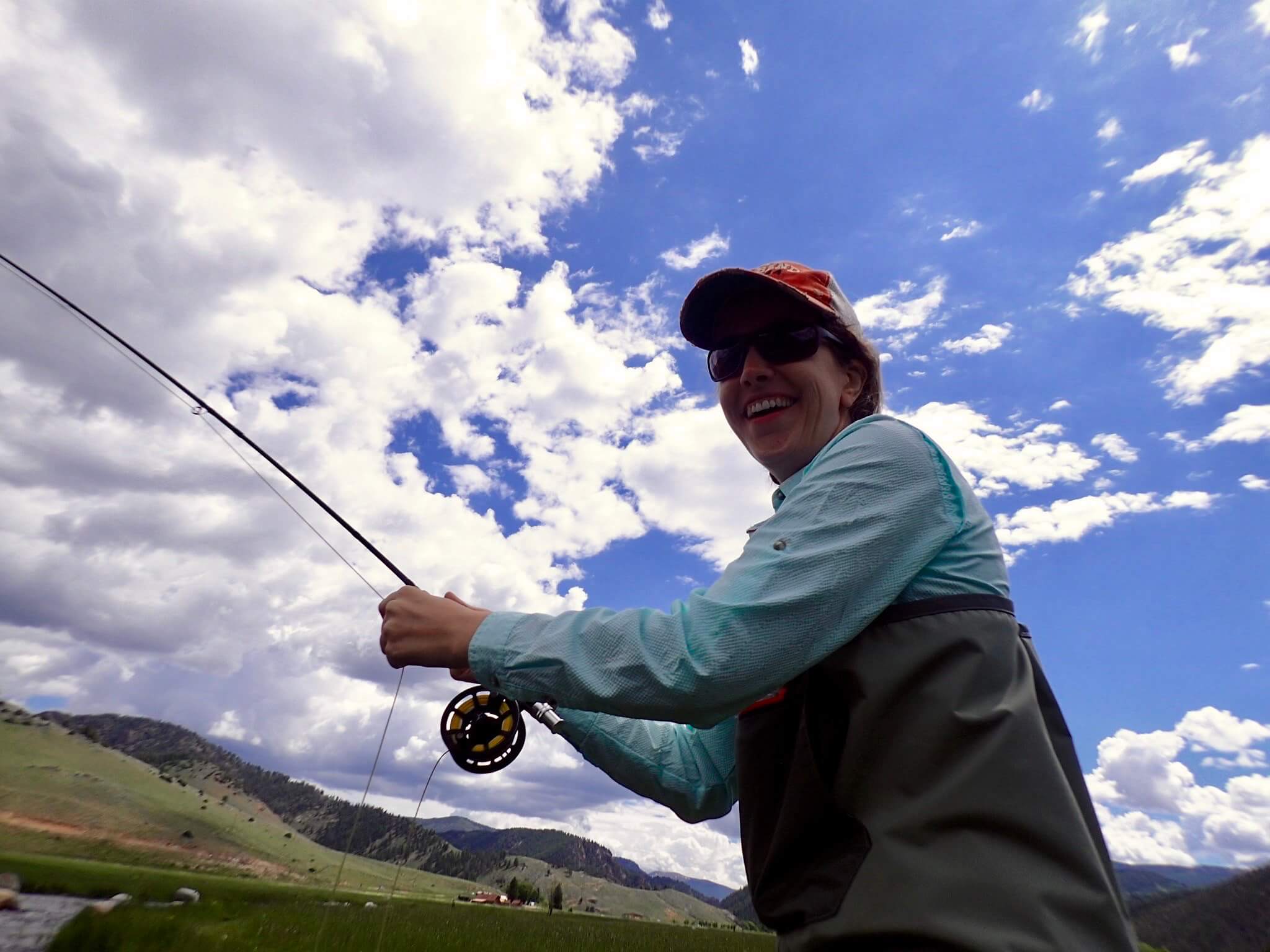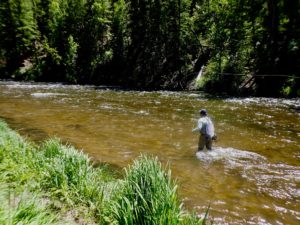
Well, after a long period of snow melt driven high water, river and fishing conditions are getting really good on the Taylor River at Wilder. Flows peaked around 1700 CFS in mid June and current flows are around 800 cfs. I anticipate the river dropping steadily over the next few weeks and releases from the dam are scheduled to be reduced from the current levels of 550 cfs to 470 cfs on July 20. Flows are at approximately 160% of normal and wading is still somewhat limited. The water is clear and an abundance of different bugs are hatching.
We are currently seeing a variety of Stoneflies, Caddis and Mayflies hatching throughout the day, including Yellow Sally’s and Golden Stones, BWO’s, PMD’s and Flavs. I have noticed a large amount of Golden stones this year and fish are chowing on the nymphs as they migrate to the banks to hatch.
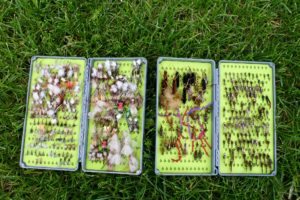 Mornings are always tricky on the river as the fish know that a hatch will come later in the day so are somewhat relaxed on their feeding in the morning. Caddis begin their egg laying flights when the sun hits the water and in shallow areas, a small Elk hair or Parachute Caddis can bring up some morning fish. Pay attention to the Caddis’ behavior when they hit the water. You will notice them bouncing off the surface laying their eggs and the occasional trout rising up to eat them. My favorite technique during this time is skating or dapping a Caddis imitation on the surface. To help keep the fly afloat I like a long fine leader and typically take a 9 foot 4x leader and add 30” of 5X tippet on the end. This long leader will help your fly float and create a more natural presentation than a shorter, heavier leader which will drown the fly. Twitch your fly on the surface and skate it lightly over likely areas. If a fish takes your fly when it is skating, resist the urge to pull up and set. Instead drop your rod tip and let him turn, then he will hook himself. If you pull too early you will not hook the fish.
Mornings are always tricky on the river as the fish know that a hatch will come later in the day so are somewhat relaxed on their feeding in the morning. Caddis begin their egg laying flights when the sun hits the water and in shallow areas, a small Elk hair or Parachute Caddis can bring up some morning fish. Pay attention to the Caddis’ behavior when they hit the water. You will notice them bouncing off the surface laying their eggs and the occasional trout rising up to eat them. My favorite technique during this time is skating or dapping a Caddis imitation on the surface. To help keep the fly afloat I like a long fine leader and typically take a 9 foot 4x leader and add 30” of 5X tippet on the end. This long leader will help your fly float and create a more natural presentation than a shorter, heavier leader which will drown the fly. Twitch your fly on the surface and skate it lightly over likely areas. If a fish takes your fly when it is skating, resist the urge to pull up and set. Instead drop your rod tip and let him turn, then he will hook himself. If you pull too early you will not hook the fish.
If there is no dry fly action, tie on a dry/dropper set-up and fish the edges and foam lines. Depending on the depth off the water you are fishing, this set up could include a #10 or #12 Para Adams with a 3-4 foot 5x dropper line and a size 12-16 weighted nymph. I prefer smaller nymphs in the size 16 range(or smaller) right now, but getting these deep in the runs is not that feasible in the high water unless you attach another heavy nymph or weight to your tippet. If you want to fish the really deep holes, you will need a nymph rig with an indicator or large dry, a long dropper line (6-7’), a heavy stonefly nymph and a smaller trailer nymph that might be a size 18 or 20.
As the morning progresses keep your eyes open for hatching bugs and rising fish. Typically if we are going to have a strong hatch, it will begin around 12-1 pm and go as late as 5. Then after 7 pm there may be a Caddis fall which will get the fish going again. This is the best time to be on the water now, especially if there is cloud cover as the Mayflies hatch much better with clouds. It all begins with a few bugs starting to fly and a rise here and there so keep your eyes open and get ready to find the appropriate dry as the fish become surface oriented. If you see fish making splashy, noisy rises, the chances are high that they are eating Caddis. Some will be jumping up to eat the egg layers on the surface, which you will see, and others will be chasing the pupae up from the bottom and eating them as they pop at the surface. Pay attention, because the fish chasing the pupae are not looking up to the surface to eat and likely will ignore a dry. Letting your dry or a small nymph swing at the end of your drift can be a good technique to catch these fish.
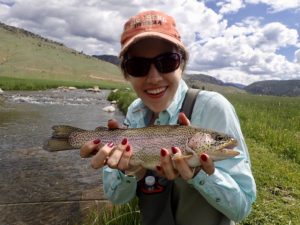 However, if you see fish sipping slowly, they are eating Mayflies. Currently we have BWO’s, PMD’s and Flavs hatching with Green Drakes coming soon. If you see fish sipping, try to determine what they are eating and select a fly to match. After you do this keep in mind that the single most important factor in catching fish on a dry in the Taylor River is a SOFT presentation. A soft presentation with the wrong fly can catch fish, but a hard presentation with the right fly will not. Long leaders(10-12’) of 5x and 6x are best. Watch the foam lines closely as these are the highest percentage areas to find fish feeding. If there is a good Mayfly hatch and the sun pops out, the hatch will slow down. Oftentimes on the Taylor we get our hatches in waves so hang in there. If another cloud comes along and you are in that 1-5 pm time window, you may see another wave and be right back in there fishing to rising fish. During the hatch is a perfect time to locate a bigger fish and cast specifically to him. Many times the little guys are faster and eat our flies first, but if you can spot a big fish rising you can cast just to him and increase your odds of hooking a big one. A drag free drift is paramount to success so subtle mends and line management can help keep the fly from dragging.
However, if you see fish sipping slowly, they are eating Mayflies. Currently we have BWO’s, PMD’s and Flavs hatching with Green Drakes coming soon. If you see fish sipping, try to determine what they are eating and select a fly to match. After you do this keep in mind that the single most important factor in catching fish on a dry in the Taylor River is a SOFT presentation. A soft presentation with the wrong fly can catch fish, but a hard presentation with the right fly will not. Long leaders(10-12’) of 5x and 6x are best. Watch the foam lines closely as these are the highest percentage areas to find fish feeding. If there is a good Mayfly hatch and the sun pops out, the hatch will slow down. Oftentimes on the Taylor we get our hatches in waves so hang in there. If another cloud comes along and you are in that 1-5 pm time window, you may see another wave and be right back in there fishing to rising fish. During the hatch is a perfect time to locate a bigger fish and cast specifically to him. Many times the little guys are faster and eat our flies first, but if you can spot a big fish rising you can cast just to him and increase your odds of hooking a big one. A drag free drift is paramount to success so subtle mends and line management can help keep the fly from dragging.
Typically between 4 or 5 and 7 pm, there is a major lull in the action as fish have been feeding all afternoon. If you experience this, it might be a good time to sit back and wait for late evening when they might well start chowing again. After 7 pm you can assume that almost any fish rising will be eating Caddis.
As always, your two biggest weapons are stealth and observation. Where I used to guide on Silver Creek in Idaho, a local guy put up a great sign by the stream. It said “Remember you are on the other side of the river”. Peoples’ tendencies are always to cast to the other side of the river. But if you are on the other side, you’ll want to cast to this side. Start observing before you arrive at the water. Oftentimes you will see a big fish right where you were about to step. Start close and be observant and your success rate will be much higher than if you just walk down and start casting long.
Over the next few weeks, the river will be dropping more and hatches and rising fish should intensify. The dry fly game is on!
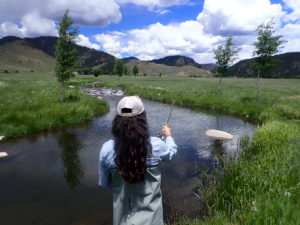 The Dream Stream has been on fire all season. The fish are super energetic and love to eat on the surface. The challenge is that they are very spooky, particularly in bright sun. Typically, we have been doing super well with a light dry/dropper set up. A size 16 Pheasant Tail has been deadly. However in recent days I have removed the droppers and have been fishing dry only with higher success. The hay meadow is full of giant Caddis, light tan wings, dirty yellow body, size 14. A #14 Elk hair Caddis or Stimulator on a 10-12 foot 5x leader is a great set up. Long light casts in the foam lines will produce some violent strikes. During late mornings and early afternoons there can be a mild BWO hatch but fish will be rising and can be fooled with a small dry. While it is not quite Hopper season yet, there are small (1 inch) hoppers in the hay meadow and a well presented Hopper can draw some voracious strikes. This is a good place to work on making a high backcast, as the hay is now almost shoulder height and is eager to trap low thrown flies.
The Dream Stream has been on fire all season. The fish are super energetic and love to eat on the surface. The challenge is that they are very spooky, particularly in bright sun. Typically, we have been doing super well with a light dry/dropper set up. A size 16 Pheasant Tail has been deadly. However in recent days I have removed the droppers and have been fishing dry only with higher success. The hay meadow is full of giant Caddis, light tan wings, dirty yellow body, size 14. A #14 Elk hair Caddis or Stimulator on a 10-12 foot 5x leader is a great set up. Long light casts in the foam lines will produce some violent strikes. During late mornings and early afternoons there can be a mild BWO hatch but fish will be rising and can be fooled with a small dry. While it is not quite Hopper season yet, there are small (1 inch) hoppers in the hay meadow and a well presented Hopper can draw some voracious strikes. This is a good place to work on making a high backcast, as the hay is now almost shoulder height and is eager to trap low thrown flies.
Please do your best to play the fish quickly and keep them in the water while you remove the hook and make your release. These fish fight hard and any time out of the water can be damaging. Always revive your fish until he makes a strong kick and then observe him for a minute or two to make sure he is not belly up. If this happens, re-net the fish and bring him quickly to a fast moving stretch of water where you can hold him in the current until he gets enough oxygen to recover. Always wet your hand thoroughly before handling a fish and handle them gently.
All the ponds at Wilder are fishing well right now. There is an epic daily Damselfly hatch and you will see these flying all over the edges of the ponds. You will also see many Browns lying still on the edges, watching the shoreline reeds for Damsel nymphs getting ready to hatch. Like the ambush predators they are, they will lie there motionless until they detect movement and then pounce violently on their prey. You will also see the fish jumping up into clouds of flying Damselflies and chomping them in the air. Very cool behavior. This being said, a Damsel dry should be your first choice for fishing the ponds right now. The males are a bright blue and I like a bright blue adult dry imitation. Cast it out there quietly, wait a few secs and give it a light twitch. Repeat a few times, making sure to let it lie motionless between twitches. Look for rising fish and cast to them. If this does not work, you can try Para Adams, Midges, Hoppers and other terrestrials with a small dropper if needed. Generally if you catch a fish or two in a pond, the fish will get super spooky. If this happens change ponds and start again. There are some monsters in the ponds so I recommend a minimum of 4x tippet. If all else fails, tie on a Wooly Bugger (black or olive) and cast it out. Remove the slack from your cast and just let it drop, After a few seconds I like a couple of sharp 6 inch strips, then let it be still again. Many times the fish eat as the fly is falling with slack, so carefully watch your fly line or leader and at any sign of movement lift the rod, set the hook and get ready to let the fish run.
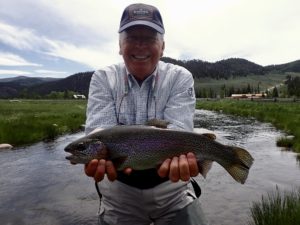
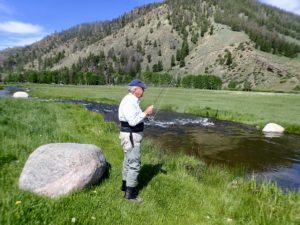 Try to remember that your first cast to an area is the highest percentage cast for a fish. I see people all the time that start with a couple of bad casts and then “get it together” and start casting better and catching small fish. What happens is that with one or two bad casts or drifts to an area, the big fish will move quietly move off or shut down, leaving only the little guys to play with. Make your first cast to an area count and it might surprise you. When fish don’t know you’re there, they can be easy to catch but when they know you’re there, it becomes a much more difficult challenge.
Try to remember that your first cast to an area is the highest percentage cast for a fish. I see people all the time that start with a couple of bad casts and then “get it together” and start casting better and catching small fish. What happens is that with one or two bad casts or drifts to an area, the big fish will move quietly move off or shut down, leaving only the little guys to play with. Make your first cast to an area count and it might surprise you. When fish don’t know you’re there, they can be easy to catch but when they know you’re there, it becomes a much more difficult challenge.
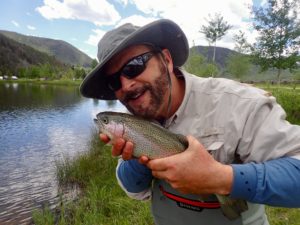 As always, please pinch your barbs and keep the fish in the water. If you must have a photo, please use the 5 second rule. Wet your hands and hold the fish up for a quick pic. Do not keep him out of the water for more than 5 seconds or you will damage the fish. Holding fish out of the water and up in the air for a photo is no longer cool. The best pics are of the fish in the water, not struggling to breath air.
As always, please pinch your barbs and keep the fish in the water. If you must have a photo, please use the 5 second rule. Wet your hands and hold the fish up for a quick pic. Do not keep him out of the water for more than 5 seconds or you will damage the fish. Holding fish out of the water and up in the air for a photo is no longer cool. The best pics are of the fish in the water, not struggling to breath air.
As always I’ll look forward to seeing you all on the water. Please feel free to contact me directly for questions, concerns or ideas.
Keep your backcasts high (but out of the trees)!
Headed to CB this summer? While in town embracing all that Crested Butte has to offer this summer season, make plans to visit with Brad Willett and discuss Wilder on the Taylor real estate. (970) 641-4545

